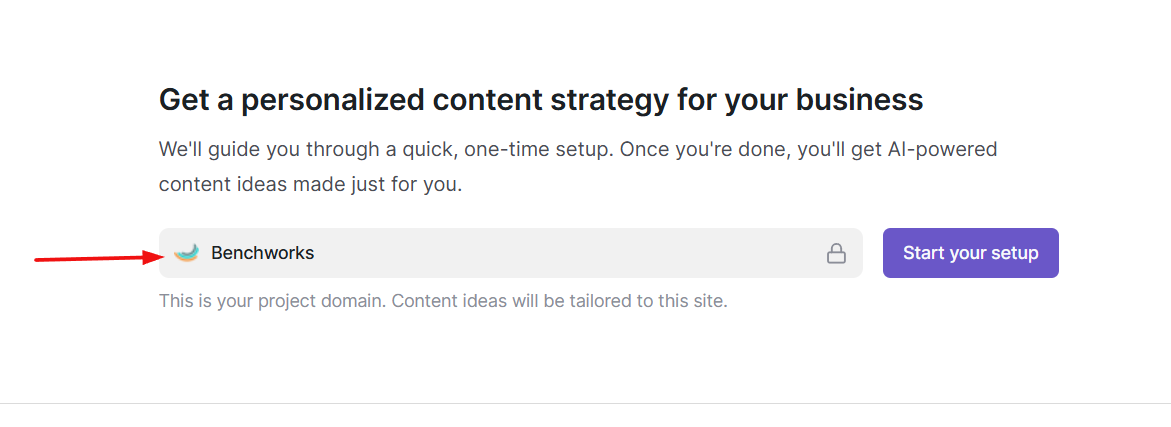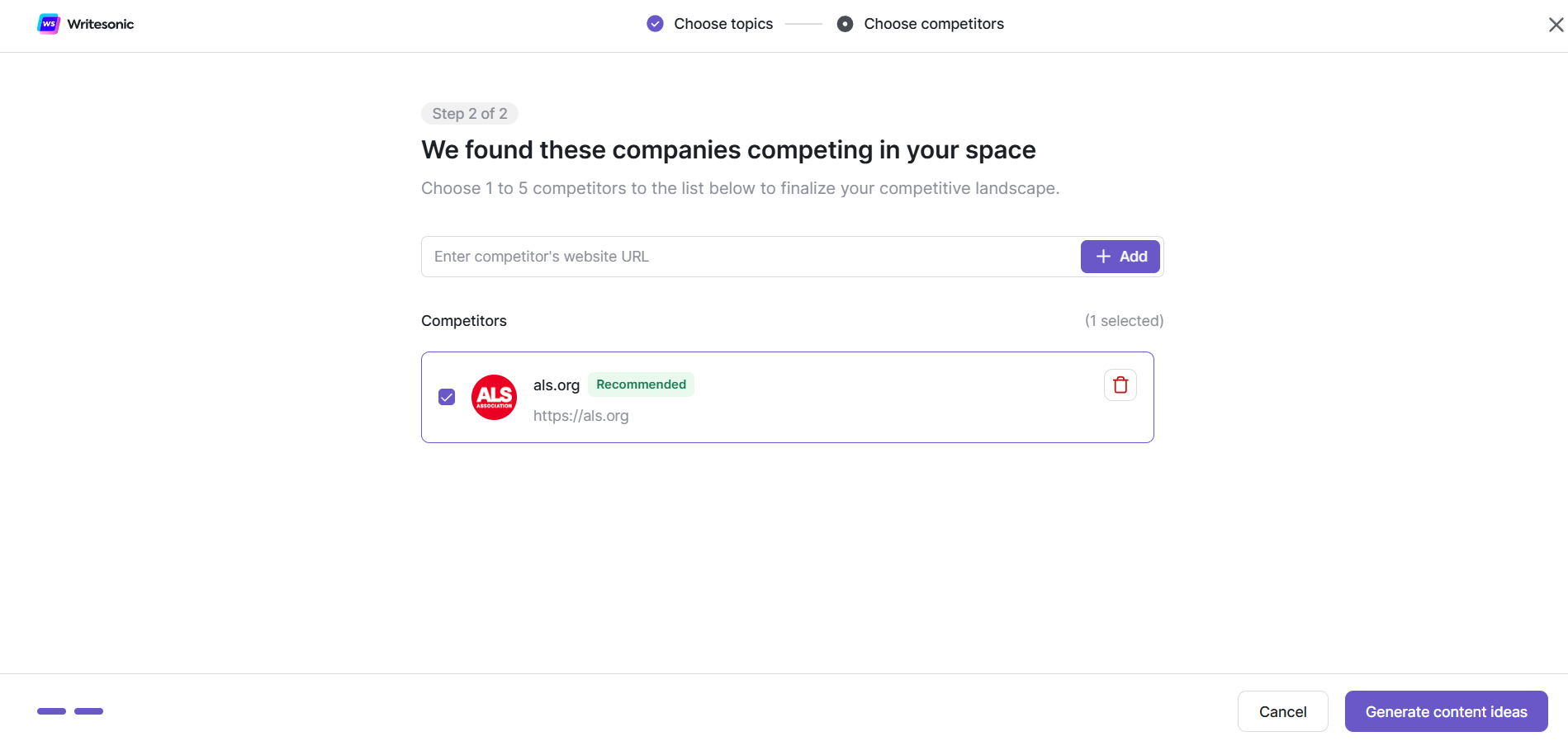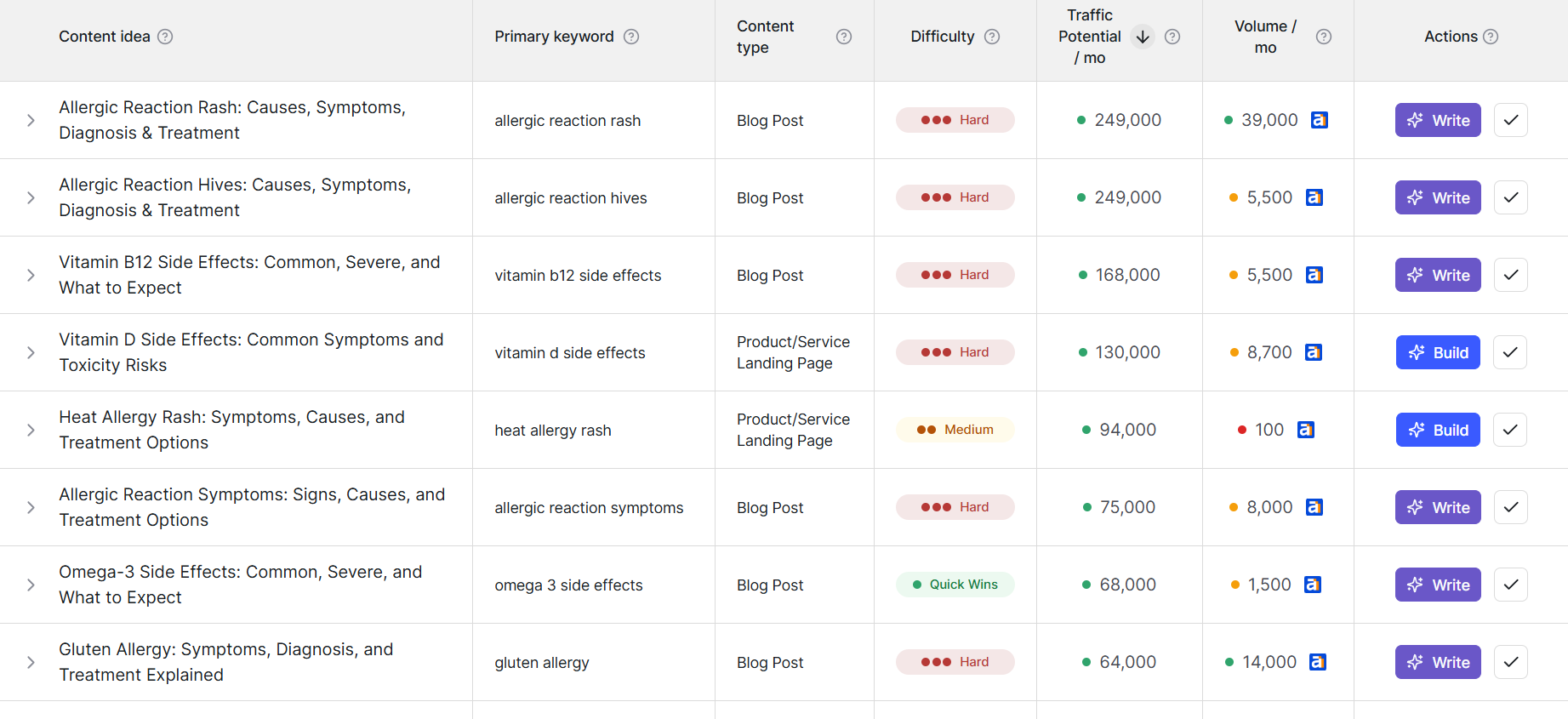Content Strategy Planner
How to Use the Content Strategy Planner to Create a Content Roadmap
Content planning often feels like guesswork. You may have some keywords in mind or a few ideas based on what competitors are doing, but turning that into a focused strategy takes time and effort. It’s easy to miss key opportunities or create overlapping content that doesn’t perform.
Our Content Strategy Planner is built to remove that friction. It helps you make informed decisions about what to publish and why.
Here’s what makes it useful:
- It automates large-scale keyword and competitor research, so you don’t have to rely on manual tools.
- It shows you which topics have strong traffic potential and how difficult they are to rank for.
- It aligns content with your business goals by organizing ideas based on funnel stage and intent.
- It prevents duplication by highlighting unique opportunities that complement your existing content.
- It connects strategy with execution. Once you’ve chosen an idea, you can launch directly into content creation using our AI writing tools.
Whether you’re launching a new site or scaling an existing program, the tool gives you a clear starting point, backed by search data.
In this walkthrough, we’ll go step by step through the entire process—from setting up your strategy foundation to generating ideas, prioritizing opportunities, and turning them into content.
1. Launch the Content Strategy Planner
If you haven’t created a content strategy project yet, go to the Content Strategy page. You’ll be prompted to enter a few key details to help the tool generate your roadmap.
To begin, enter your domain name and click Next. This allows the tool to tailor all recommendations based on your website’s authority, structure, and existing search visibility.

Next, select 2 to 5 of your core topics. These should reflect the main areas your business wants to build content around.

After that, enter your competitors. Once all three steps are complete, click Generate content ideas to begin the research process.

Tip: You can complete the setup with default settings to get started quickly. For more customized insights, take a few extra moments to define your business topics and target market.
2. The Research
After setup, the Content Strategy Planner starts analyzing the inputs you provided—your domain, topics, and competitors—to build a personalized roadmap of content ideas.
There’s nothing else you need to do at this point. The tool runs the entire research process automatically in the background.
Don’t want to wait? You’ll get a notification straight into your email inbox once the roadmap is complete.

Once the research is complete, your results will appear in the Your Personalized Content Roadmap panel at the top of the dashboard. This panel gives you a snapshot of how much data was processed to create your strategy.
Here’s what each part of the panel shows:
-
Comprehensive Keyword Insights
Displays how many keyword opportunities the planner identified. These are filtered for intent, traffic potential, and how well they align with your business.
-
Organic Competitor Research
Shows how many competitor domains were scanned. This helps the tool surface gaps in their content—topics they’re ranking for that you haven’t covered yet.
-
Time Saved
Estimates how much manual research the tool automated. This typically includes keyword research, SERP analysis, and competitive comparison—equivalent to 40–50 hours of work.
Below the summary, you’ll also see a Custom Strategy Blueprint, which outlines the data sources used to generate the roadmap:
- Ahrefs: Used for keyword ideas, traffic estimates, and difficulty scores
- Google Keyword Planner: Supplements the roadmap with search volume and related queries
- Google Search: Analyzes live SERPs to understand what types of content rank and why
You don’t need to configure or manage these sources—the planner handles everything behind the scenes.
Note: This overview isn’t just informational. It helps you understand the depth and credibility of your roadmap. Every idea that follows is backed by real-time search data and competitive analysis, not guesswork.
3. Review Your Roadmap
Once the research is complete, scroll down to the Content Ideas table to view your personalized roadmap. This is where you’ll start evaluating and selecting what content to work on next.
Each row of the table represents a content opportunity tailored to your domain and business focus. By default, the ideas are sorted based on relevance and impact, but you can sort them further by clicking on the column titles.

Each column in the table provides key data to help you assess what to prioritize:
-
Content Idea
The suggested topic or page title. These are generated to align with your selected themes and target market.
-
Primary Keyword
The main keyword the content should target. Chosen for search intent and ranking potential based on SERP analysis.
-
Content Type
Indicates the ideal format for the topic—blog article, landing page, or service page—based on what ranks best for that keyword.
-
Difficulty
A score from 0–100 showing how competitive the keyword is. Lower scores are easier to rank for. Quick Wins are labeled to highlight low-difficulty ideas.
-
Traffic Potential per month
An estimate of the monthly traffic you could gain if your content ranks well for the keyword.
-
Volume per month
The number of monthly searches for the primary keyword.
-
Actions
A “Build/Write” button that opens Chatsonic/Article Writer 6 to start content creation.
Not sure which topic to choose first? Start with ideas marked as Quick Wins. They’re easier to rank for and can help you gain early traction. You can also compare traffic potential and keyword volume to find opportunities that offer strong returns with less competition.
Or, simply use the filters provided on top of the table.
4. Filter and Prioritize Content Ideas
As your roadmap grows, filtering becomes one of the most effective ways to stay focused and make confident decisions. To begin narrowing your list, scroll to the top of the Content Ideas table and open the Filter options.

Start by filtering by Goal to choose topics belonging to specific funnel stages:
- Get Visitors/Top of Funnel (ToFu) – Ideas meant to attract new visitors. These are usually broad, awareness-focused topics suited for blog content.
- Build Authority/Middle of Funnel (MoFu) – Content that educates and builds authority. Good for users exploring solutions or comparing options.
- Generate Sales/Bottom of Funnel (BoFu) – High-intent topics for users who are close to converting. Often mapped to landing pages or service offerings.
If you’re focused on producing a specific type of content, switch to the Page Type filter instead.

You can choose to view only:
- Blog Articles – Best for educational and SEO-driven pieces.
- Landing Pages – Designed for campaigns, offers, or product highlights.
- Service Pages – Focused on business offerings or core services.
To stay within your strategic focus areas, use the Topic filter.

This narrows the list to content ideas that fall under one of your originally selected core themes.
You can also filter by Difficulty to sort ideas based on how competitive the keyword is:

🟢Quick Wins – Low-competition keywords you can target for faster results.
🟡Medium – Balanced opportunities for steady growth.
🔴Hard – More competitive topics that require strong content and backlinks.
Each filter gives you a different view of the roadmap. While only one can be applied at a time, it’s easy to switch between them to plan based on your current priorities.
5. Build Content from Your Strategy
Once you’ve selected a content idea from the roadmap, look at the Actions column on the right. Depending on the content type, you’ll see one of two options: Write or Build.

- Click Write for blog articles. This will open Article Writer 6, where your selected keyword and topic are automatically pre-filled. The tool guides you through an outline, intro, and full-body draft step by step.
- Click Build for landing pages or service pages. This will open Chatsonic with a pre-loaded prompt based on the keyword and content type. You can customize the prompt or generate a first draft instantly.
Both options are designed to take you from strategy to content creation without switching tools or copying over information manually. The keyword, topic, and suggested format are carried over automatically to ensure your draft stays aligned with the original recommendation.
Once inside the writer, you can adjust the tone, add brand-specific context, or refine the prompt to better match your goals.
Tip: Whether you use Article Writer or Chatsonic, treat the output as a first draft. Layer in your expertise, product details, or internal links before publishing to get the most value out of the tool.
Quick Tips to Get Started
Your roadmap is ready, and the content creation tools are built in. Now it’s about using them effectively. The following tips will help you take focused action, avoid common pitfalls, and get faster results from your strategy.
-
Start with a clear focus
Limit your initial setup to a handful of core topics tied to your core offerings or high-priority goals. A narrower focus leads to more actionable, relevant content ideas.
-
Prioritize content with lower difficulty
Use the Difficulty filter to find Quick Wins. These are ideal if you’re working with a newer site or want to build momentum quickly before taking on more competitive topics.
-
Align content with intent
Match funnel stages to your business objectives. If you need traffic, focus on top-of-funnel blog articles. If you’re supporting a product launch, look at bottom-of-funnel landing pages or service pages.
-
Build consistently, not all at once
Pick a few content ideas each week and use the Write or Build button to create them over time. This keeps your publishing pace manageable while maintaining quality.
-
Use filters to shift focus as goals evolve
As your priorities change—whether you’re targeting conversions, authority, or new product areas—revisit the roadmap and apply a new filter to find what fits next.
-
Treat the AI output as a starting point
The Write and Build options give you a structured draft fast. From there, customize with brand messaging, real examples, and internal links before publishing.
Tip: Keep checking back. As your site grows and your content library expands, the planner continues to surface new gaps and opportunities worth pursuing.
FAQs on Content Strategy
- How often is the data updated?
The Content Strategy Planner uses real-time data pulled from trusted APIs, including Ahrefs and Google. Keyword volumes, SERP analysis, and competitor insights are updated automatically during each new strategy setup.
- Can I add custom keywords to the roadmap?
Yes. During the setup process, you can enter custom topics or keywords that reflect your business focus. The planner will use these to find and score related content opportunities.
- What’s the difference between Traffic Potential and Volume?
Volume refers to the monthly number of searches for a keyword. Traffic Potential estimates the number of visitors you could realistically attract if you rank well—based on how traffic is distributed across top-ranking pages.
- How is keyword difficulty calculated?
Difficulty is scored from 0 to 100 based on factors like domain authority of current top-ranking pages, backlink strength, and SERP competitiveness. Lower scores indicate easier opportunities.
Updated 5 months ago
